|
The Black Paintings 1985-86
a room of wall size paintings in ink and enamel on
pleated neoprene, 14’ x 22’ x 28’
Collection; Museum of Modern Art, NY
|
A grand scale room of painted black rubber curtains based on Jean Genet’s play: The Blacks: A clown show. (catalog) |
|
|
“The grandest experiment is Izhar Patkin’s room-size “The Black Paintings,” painted in white ink on black rubber curtains. Its myriad figures includes Manet’s “Olympia,” who reigns over a court of magical and demonic creatures. In its own way, it is late 20th century Sistine Chapel, absorbing and provocative.”
-Frederick M. Winship
UPI Service
April 18, 1987 |
|
|
| |
Presenting... The Cast by Marja Bloem
Stedelijk Museum catalog, 1990
At the end of the performance the curtain opens to applause; and there the public
sees them - the cast bowing appreciatively. The audience knows them all; in the
course of the play each has shown his personality and they have become old
friends.
In fact, it is strange that the performance should start with those watching ignorant
of who is who. At a player's first entrance one is often unsure of his role in the
play, a previous formal introduction being quite unusual.
Patkin - that builder of exhibitions as if they were theatrical productions - goes
about it differently. He introduces his dramatis personae.
For his work The Black Paintings he calls on the associations sparked by Genet's play
Les Negres. ln the initial lines of his text Genet writes that the curtain is raised ...
the black velvet curtain ... revealing to the white audience black players masked to
personify whites. As you enter, Patkin uses a technique related to lithography
(a craft in which he trained for a while) to show the cast of the play side-by-side,
on two levels, ready to greet the public. All are labeled with a name. Each is
equipped with symbols to establish identity throughout the play. Hence, the queen
has a dazzling crown (Though the dazzle comes from a miner's lamp rather than
jewels); Archibald is accompanied by cats and a bat; Diouf has as escorts a black
putto with pistol and a baby chicken. And so forth, and so on. Many of the symbols
come from Patkin's recollected images of art, but literature is represented too;
perhaps not immediately visible to everyone, but often vice versa. To take an
example: Manet painted Olympia with a black female slave. Patkin sees the
divergence of rank repeated in the black and white cat which crops up every so
often (Olympia too includes a cat). He immediately transfers these images to his
surface. Having met the players outside the auditorium, you enter the area where
the play has become an installation. You recognize the figures - and this time the
entire plot unfolds not behind the curtain on stage - but on the curtain itself (as a
legible narrative). Patkin's precise aim to stimulate the public's imagination makes
familiarity with Genet's plot unnecessary.
Interpretation is free and open. You may project your own story or stories. Patkin
merely furnishes the framework.
|
The Cast of Characters Portfolio, 1988
Set of 13 lithographs, 21” x 17”
published by Maurice Sanchez, Derriere L'Etoile Studios, NYC |
|
|
|
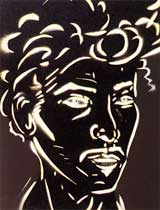 |
Deodatus Village
(Gerard Little)
“For you I could invent anything:
fruits, brighter words, a two wheeled
wheel barrow, cherries without pits,
a bed for three, a needle that
doesn’t prick. But gestures of love,
that’s harder . . . still, if you really
want me to . . .” |
|
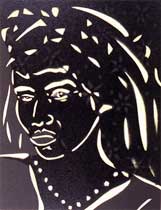 |
Stephanie Virtue Secret-Rose Diop
(The Meta Bride, Patkin)
“I’ll help you. At least, there’s one sure thing: you won’t be able to wind your fingers in my long golden hair . . . ” |
|
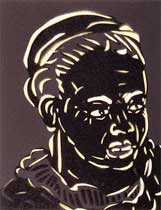 |
Augusta Snow
(Olympia’s maid, Manet)
“ . . . an eater and guzzler of Whites and all other colors, a drooling, sweating, belching, spitting, coughing, farting, goat-fucker, a licker of boots, a good for nothing, sick, oozing oil and sweat, limp and submissive . . .” |
|
|
| Archibald Absalom Wellington . . . . . . . . . . . . |
. . . . . . . . . . . . Willi Smith |
| Deodatus Village . . . . . . . . . . . . . . . . . . . . . . . |
. . . . . . . . . . . Gerard Little |
| Adelaise Bobo . . . . . . . . . . . . . . . . . . . . . . . . . |
. . . . . . . . . . Cheryl Smith |
| Edgar Alas Newport News. . . . . . . . . . . . . . . . |
. . . . . . Winston Robinson |
| Augusta Snow . . . . . . . . . . . . . . . . . . . . . . . . . |
. Olympia's Maid (Manet) |
| Felicity Trollop Pardon . . . . . . . . . . . . . . . . . . |
. . . . . . . . . Robin McClary |
| Stephanie Virtue Secret-Rose Diop . . . . . . . . |
. The Meta Bride, (Patkin) |
| Diouf . . . . . . . . . . . . . . . . . . . . . . . . . . . . . . . . . |
. . . . . . . . . . Jerib Carson |
| Missionary . . . . . . . . . . . . . . . . . . . . . . . . . . . . |
. . . . . . . . . .Lloyd McNeill |
| Judge . . . . . . . . . . . . . . . . . . . . . . . . . . . . . . . . |
. . . . Orlando Estario Held |
| Governor . . . . . . . . . . . . . . . . . . . . . . . . . . . . . |
. . . . . . . . . . Nate Jackson |
| Queen . . . . . . . . . . . . . . . . . . . . . . . . . . . . . . . . |
. . . . . . . . . Alberta Wright |
| Valet . . . . . . . . . . . . . . . . . . . . . . . . . . . . . . . . . |
. . . . . . . . . . . . . .Al Jolson |
|
|
|
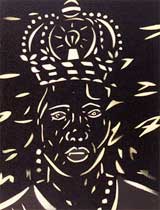 |
Queen
(Alberta Wright)
“ . . . An eternal ruin. It’s not that time corrodes me, it’s not fatigue that makes me forsake myself, it’s death that’s shaping me. . .” |
|
 |
Judge
(Orlando Estario Held)
“ . . . Act of July 18th, Article 1. God being dead, the color black ceases to be a sin; it becomes a crime. . .” |
|
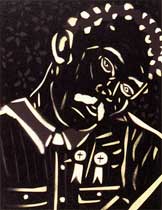 |
Governor
(Nate Jackson)
“ . . . You can say what you like about them, but those fellows are terrific fuckers.” |
|
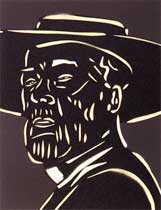 |
Missionary
(Lloyd McNeill)
“It was I who brought you knowledge of Hell. How dare you cast me into it.” |
|
 |
Valet
(Al Jolson)
“Nothing, Shall I go?” |
|
|
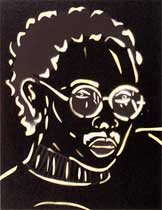 |
Archibald Absalom Wellington
(Willie Smith)
“The Tragedy will lie in the color black! It’s that that you’ll cherish, that that you’ll attain, and deserve. It’s that that must be earned” |
|
 |
Diouf
(Jerib Carson)
“The first thing to tell you is that they lie or that htey are mistaken. They are not white, but pink or yellowish.” |
|
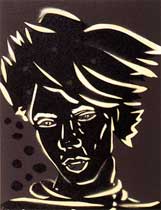 |
Adelaide Bobo
(Cheryl Smith)
“ . . . in order to refer to ourselves, we don’t adorn our metaphors with stars. Or grand nocturnal images. But with soot and blacking, with coal and tar” |
|
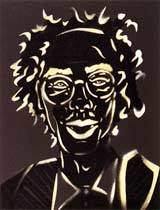 |
Edgar Alas Newport News
(Winston Robinson)
“I did it in order to sing better, and louder, and I even danced.” |
|
 |
Felicity Trollop Pardon
(Robin McClary)
“Beyond that shattered darkness, which was splintered into millions of Blacks who dropped to the jungle, we were Darkness in person. Not the darkness which is absence of light, but the kindly and terrible Mother who contains light and deeds.” |
|
|
|
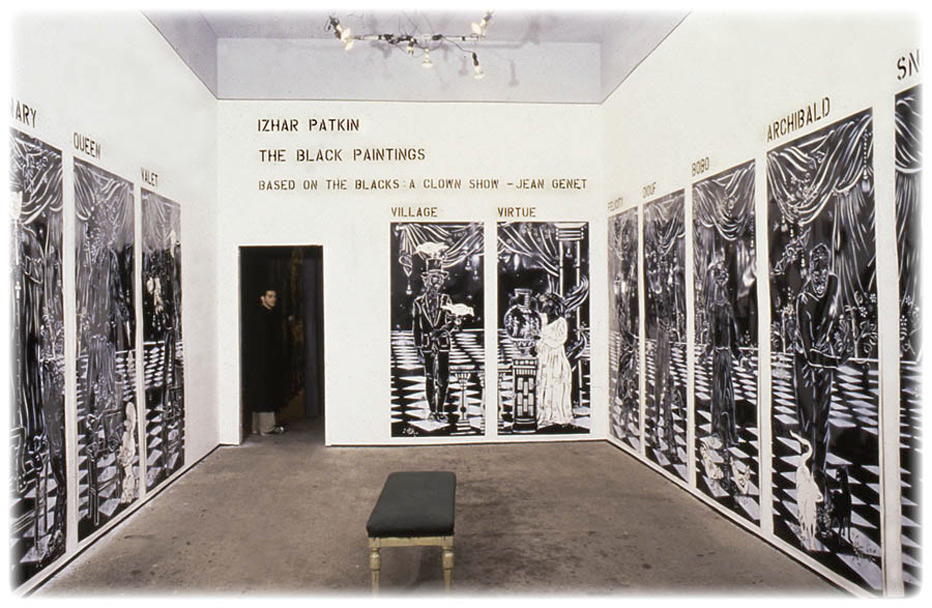 |
| |
Installation view of the entry room at Limbo gallery, New York, 1986
Viewers were introduced to the cast of characters at the exhibition’s entry, before continuing on to The Black Paintings in the following room. |
|
|
|
A synapsis for The Black Paintings
by Susan Martin
catalog published by Limbo Gallery, 1986 |
|
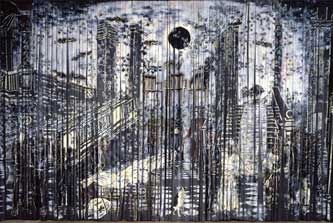 |
“DAWN” Back Wall
ink on Neoprene 14’ x 22’
Not Apocalypse, but an extraordinary solar eclipse, puts Queen and company out of power. Surprise-Surprise, a reporter’s scoop: two chairs mistaken for a coffin, as morning unveils the glorious ruins of the ‘palacial’ nightclub!
Wedding. The stereotypes dress for better or for worse.
Little Orphan Cupid blows bubbles in the sky. Mama may have, Papa may have, but who will bless the child that’s got its own? |
|
|
Left Wall “BLACK ROLLS”
ink on Neoprene 14’ x 28’
The hind that would be mated by the lion must die for love - Shakespeare. Unless they are having cocktails. Queen sips with her valet. Hour of judgement. The governor, the missionary, and the judge are fast asleep in their box.
Downstairs, the Blacks are working hard for their color. Diouf, as a woman, dressed to be killed, is the target of Village’s make-believe hate. A black pony bears a notorious ghost which we shall meet again. In this God-free underworld, anything with wings gets swept away. |
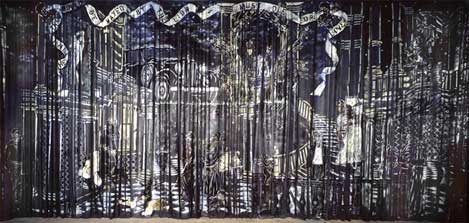 |
|
Right Wall “White Ghost”
ink on Neoprene 14’ x 28’
Are they just married or just murdered? Who’s to judge? Not the poodle with the note nor the cupid with his ballistic sting.
Above: the court kneels before her majesty’s majority.
Below: Village, our hero, dutifully puts a vision out of its misery. |
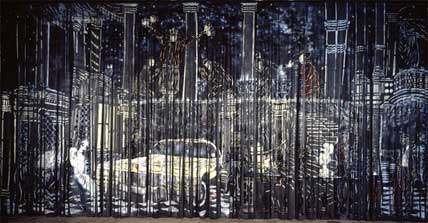 |
|
|
“NIGHT” Front Wall
ink on Neoprene 14’ x 22’
In the beginning there is the moon. Bobo and Felicity dance the minuet oblivious to the vile odor which appears to emanate from a catafalque. Village, Archibald, Newport News, and Diouf aren’t dancing.
Upper Level: behind her white mask and under her coal miner tiara, Queen consolidates her power.
|
|
|
|
Installation views Whitney Biennial, 1987 |
|
|
|
| |
| |
Installation views Stedelijk Museum, 1990 |
|
|
|
| |
Installation views Limbo
NYC, 1986 |
 |
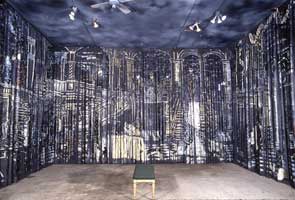 |
|
|
|
|
Detail Views of the ghost story in The Black Paintings
In Genet’s play, the blacks are instructed to kill a white prostitute.
At the start of the play, there is a white shroud that covers coffin shaped object where her body should be.
Later, we learn that the murder never happens, and the shroud turns out to be draped over a couple of empty chairs.
Patkin solved the dilemma of how to depict a murder that never happens by inventing the narrative of the killing of a ghost.
The ghost is shaped to resemble Manet’s reclining courtesan, Olympia. |
|
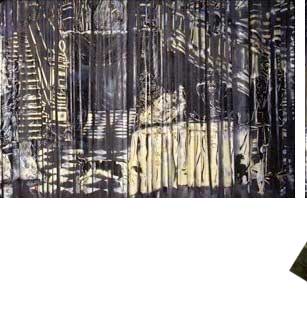 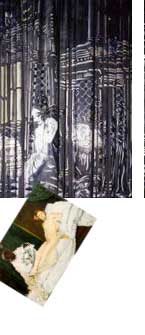 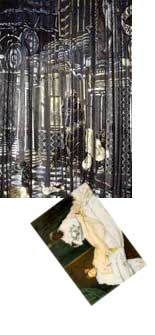 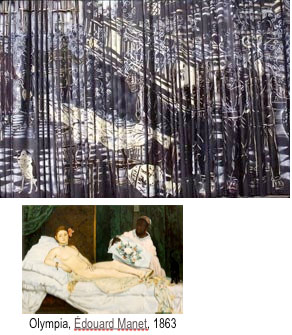 |
|
Narrative Painting by Herbert Muschamp
catalog published by Limbo Gallery, 1986
Izhar Patkin’s Black Paintings are generated by the meshing of two narrative programs. The first of these is Jean Genet’s play, THE BLACKS. The second is an ancient myth about the modern artist.
According to this myth, the artist reenacts the ritual of succession in ancient Greek fertility cults. This ritual consisted of two parts. In the first part, a young pretender challenges the old ruler and fights him to the death. In the Poetics, Aristotle suggests that the tragic drama originated in this ritual agon. And in the myth of modern art, young pretenders are called upon to challenge and defeat the rule of stale convention in order to insure the fertility of their culture.
In the second part of the Greek ritual, the new ruler and his queen lead the community in a wedding procession and celebration called the “komos”. F.M. Cornford suggests that comedy originated in this event. Patkin’s work is situated here. In his narrative, agony and struggle are also seen as stale conventions which divide us into black and white. When comedy is queen, the types are unable to hold up their stereos; the invitation withdraws the confrontation; the Baroque piazza of mob repression turns into a square dance; cupid beckons the way up the down staircase; and the only thing allowed to come between us is a table for two.
|
A few words on Jean Genet’s play “The Blacks: A Clown Show"
The Blacks: A Clown Show (Les Nègres) is a play by the French dramatist and novelist Jean Genet. Published in 1958, it was first performed in a production directed by Roger Blin at the Théatre de Lutèce in Paris, opening on the 28th October, 1959.
If a prefatory note, Genet specifies the performance conditions under which he anticipates the play would be performed, revealing his characteristic concern with the politics and ritual of theatricality:
"This play, written, I repeat, by a white man, is intended for a white audience, but if, which is unlikely, it is ever performed before a black audience, then a white person, male or female, should be invited every evening. The organizer of the show should welcome him formally, dress him in ceremonial costume and lead him to his seat, preferably in the first row of the orchestra. The actors will play for him. A spotlight should be focused upon this symbolic white throughout the performance.
But what if no white person accepted? Then let white masks be distributed to the black spectators as they enter the theater. And if the blacks refuse the masks, then let a dummy be used."
The Blacks was, after The Balcony, the second of Genet's plays to be staged in New York. The production was the longest-running Off-Broadway non-musical of the decade. This 1961 New York production opened on the 4th May at the St Marks Playhouse and ran for 1,408 performances. It was directed by Gene Frankel, with sets by Kim E. Swados, music by Charles Gross, and costumes and masks by Patricia Zipprodt. The original cast featured James Earl Jones as Deodatus, Roscoe Lee Browne as Archibald, Louis Gossett, Jr. as Edgar, Cicely Tyson as Stephanie, Godfrey Cambridge as Diouf, Maya Angelou as the Queen and Charles Gordone as the Valet.
|
|
‘To you, black was the color of priests and undertakers and orphans. but everything is changing. Whatever is gentle and kind and good and tender will be black. Milk will be black, sugar, rice, the sky, doves, hope, will be black. So will the opera to which we shall go, blacks that we are, in black Rolls Royces to hail black kings, to hear brass bands beneath chandeliers of black crystal . . .’
-Jean Genet
|
|
Great Curtains I Have Known
by Herbert Muschamp
Stedelijk Museum catalog, 1990
When I was a child, my parents had a summer house at the shore with big picture windows and an unobstructed view of the Atlantic, but to me the most luxurious thing about the house were the curtains in my parent's bedroom. They were heavy, lined, and covered with pictures of seashells against a dark green background. You pulled a cord to open them. The curtains covered a bay window about seven feet wide. There was a ledge about two feet off the ground with enough headroom for a small boy to stand on it, and here, on rainy days, I put on stage shows for an audience that consisted of my older brother and the maid. The performances were mostly variations on me standing there with a grin, though later I added one or two tricks with cards and spoons, but all of this was beside the point. The real trick was pulling the cord. The point was the magic of curtains.
That magic enchanted me for years. I used to go every Wednesday to hear the local orchestra play in a very lovely hall, but one time I went there for an evening performance of the opera and saw, for the first time, the stage hung with a sumptuous gold curtain. It was as though Cinderella I'd known for years had suddenly dressed up for the ball. And there was a movie theatre I used to frequent just because it had two sets of curtains that closed and opened before each show: one that pulled open horizontally and another vertically in gathered folds. And then, many years later, I had the opportunity to watch Izhar Patkin paint his Black Paintings, in a big, filthy, unheated room on Broome Street. I used to visit this studio almost daily while the work was in process. I rarely stayed very long, but the painting changed each day, and I didn't want to miss a thing. And the painting wasn't the only thing that changed. Graham Greene once said that the difference between writing a short story and writing a novel is that the person who finished a novel is not the same person who started it. And, half the spectacle, which drew me to Broome Street, was watching this change in someone. The extraordinary thing was that you could see this as a physical process, played out in hundreds of ordinary acts: punching a staple gun, climbing a ladder, scrambling over a floor that daily grew thicker with the accumulation of paint droplets, discarded stencils, props and coffee cups.
Inevitably, the day arrived when the painting departed from the sketches, virtually architectural, that Patkin had unrolled on the floor of my living room months before, and from that point onward it was as though the artist's feet had left the ground and he became a creature of the air, jet-powered by the pressure of spray paint in his travels around a room whose walls had dissolved to reveal cities, highways, night skies, classical ruins, tribal battlefields, dance floors, fashion shows, the Museum of Modern Art. Anyone who hasn't discarded the word inspiration
from their vocabulary will understand how a witness can feel a participant under such circumstances.
Pauline Kael once wrote 'there is nothing like that moment when the lights go down and all our hopes are concentrated on the screen'. I'd say there's nothing like that moment when the lights go up on a curtain, illuminating an architecture of occasion, the use of a form to create an event. It's the visual equivalent of the drum roll, the heightening of expectation. For the Modernists, as we know, the curtain was anathema. They resisted its connotations of artifice, its division of theater from life. Surely they were right to make the absent curtain metaphor for releasing art's power into the everyday world. And just as surely, and for much the same reason, we should call the curtain back for a curtain call: not as a wall between a real world and a fake one but as a portable screen to place anywhere you need to concentrate your hopes, to watch what you thought was ordinary turn into something special. As when a fellow inmate of Genet famously placed a set of dentures atop his head where it glistened as a queen's tiara; as when Genet's prison jerk-off fantasies became literature, the thief himself Sartre's saint. |
|
Interview with Izhar Patkin
Spring 1986, New York City
by Herbert Muschamp
Stedelijk Museum catalog, 1990
HM: One of the surprise entertainments of The Black Paintings
you showed last spring (at the Limbo Gallery, New York City)
was to watch the reaction of the viewer. It was though you took
them by the hand over the threshold Into the idea of narrative In
contemporary art – It was done on such a big scale and With such
an explicit literary connection to Genet's play that they couldn't
miss It- but once they were Inside there seemed to be a
language problem. It was like watching a group of travelers
entering a foreign country and trying to order a meal. There was
food allover the place but no Berlitz handbook. The waiters
didn't understand the useful formalist words and phrases. So I
thought we could begin our conversation by describing some of
the philosophical features of Narrative Country.
IP: Well, the terrain is the voided center left by the
Enlightenment's dismissal of God, and the reason for the
language problem is that the idea of narrative has been so long
suppressed, sacrificed, to the cult of form because of its
notorious ties to that exiled central authority. The idea was to
establish the autonomy of art by liberating the artist from the
job of illustrator to the Master Storyteller. The point of using
narrative today, in turn, is to walk off the job of illustrating the
Master Story of Modern Art. Or maybe just to look for a better
job, something a bit more rewarding than moving the shapes
around.
HM: To recognize, in other words, that formalism's pretence of
objective truth was itself a romantic narrative which began as a
bill of rights and ended up, as a gag order.
IP: Calling my show The Black Paintings was polemical in
that sense, because even formalists like Reinhardt and Stella
used black metaphorically, to tell a story of which they were
acutely conscious, about Modernism as a tale of our collective
progress. My intention in the paintings was to fluff up the
narrative structure of the form-making process so that you
couldn't miss it.
HM: Some viewers, though, were concerned that they might be
missing something In the work because they weren't familiar
With Genet's text and couldn't 'read' It from your work. But the
point you seemed to be making is that with narrative painting
you don't have to know 'the story', but you might want to know
the story.
IP: People are right to be suspicious about narrative, because
the old form of narrative said that you have to know a Bible.
But formalism became a Bible too. The new form of narrative is
about making room for stories that you do not know. It is not a
literary process. The work is not illustrating the narrative, it is
generated by it in a visual medium. We had our Modern grid,
it was generated by one story, and we made it very well.
Now let's look at some others.
HM: We had our church, we had our steeple, now let's open all
the doors and see all the people. Narrative is just a tool for
ordering experience, I went out, I traveled, I met a man, I heard a
story, here it is. Years before 'appropriation' became a standard
visual tactic, Joanne Kyger wrote something great: 'Even If I only
repeat what others say, it becomes mine'. It may be dumb or
smart, true or not, but it's my version.
IP: Narrative is about allowing yourself to be a narrator, about
empowering your internal authority to write its own script. You
don't have to be God to be a narrator; you're allowed to do it
because you woke up that morning, had coffee, made some
phone calls, heard some great gossip. You don't have to run a
marathon to get to the Center of things before you've got your
story.
HM: So behind your curtains lurks a different model of self.
IP: It's not the self as a candidate for the vacant center. It's me,
it's not, please, Lord, let it be me. It's the self as a messy
drawer or container. It is enough that the information, the
notes, the memories, projects, emotions, are all in it.
They don't have to be organized in any hierarchy.
HM: Unless you're In a hierarchical mood that morning.
IP: Yes, the Center as a mood; God at breakfast, fallen Angels
over toast at lunch. |
|
HM:What was impressive about The Black Paintings was not
your use of narrative but your openness in doing so, your refusal
to be enigmatic about it. The story of 'the enigma' seems to be
the story of being afraid about the professional consequences if
you break the gag order.
IP: Even in figurative and abstract painting today there is a
denial of narrative and a celebration of ennui; this is an
acceptable form of ‘passing' as form. Everyone would be scared
to death if Napoleon really showed up but they also get
alarmed when someone refuses to put on their Napoleon
costume, or puts the hat on backwards with the price tag
dangling. I'm more interested in breathing than heroics.
Funnels and Trumpets. Take it in, dump it out. Narrative
comes into play when you discover that the air around you
doesn't exist in the same way without you; but you don't own
it. And it doesn't own you; ripping up the script if the part
doesn't suit you is an important function of narrative. I want to
shred the script that identified art exclusively with heroic
struggle.
HM: That's a traditional function of the comic script. Aristotle's
Theory was that the origins of tragedy and comedy lay in the two
parts of the ritual of succession In the ancient Greek fertility
cult. Tragedy arose from the 'agon' in which the young pretender
challenged the old ruler and fights him to the death. Comedy
arose from the 'kosmos', the wedding procession and
celebration. In the ritual of Modern Art, young pretenders are
called upon to challenge and defeat the rule of stale convention
in order to insure the fertility of the culture. Your work seems to
be about Inaugurating the second part of the cycle, about the use
of comedy as 'the ultimate civilizer', as Meredith called it.
IP: For me, this cycle started with the Meta-Bride work
I showed at Holly Solomon a few years ago. It was about a black
bride torn apart by a Snow White complex. The importance of
comedy to me is that it allows more stories to enter into our
homogeneous experience, and it infuriates a lot of people that
it does this. It is not just black and white fighting till the death;
the audience has a story to tell too.
HM: Rather than strive for the idea of essence, your work
Seems to go for the doorway, the threshold where the dualisms
collapse,
IP: One of the points of black paintings is that you cannot
seperate color from a metaphoric use, but you can transform
the metaphor. People aren't black and white, they are brown or
pinkish maybe. Every painter knows that there is no pure black
or pure white; try to find the polarities with blue black, green
black, red black. Dualisms were invented for the upper hand's
gain of power.
My objective was not a reversal, not to put black where white
is usually put, but to liberate the metaphor from the
stereotype. Black isn't hell, bad luck, the eclipse, evll, darkness,
the abyses. ln Genet's play the Blacks try to live up- or down to
these stereotypes, and they fail. But in my work they don't
even have to fail, and they don't have to succeed, either.
They are playing a game that I invented.
HM: I thought the power of the show lay not In the cease-fire of
the battle between black and white but in the collapse of the
dualism between self and environment. This is something that
probably can't be understood through photographs of the work;
it depended on the way the work surrounded the viewer; the
way the viewer entered Into the room through the work itself,
changing it on their entrance; on the scale of the figures, the fact
that the figures were at once flattened into the two dimensions of a picture plane and also, because of the curtain folds,
protruded into the spectator's space,
IP: The most common interpretation of Genet's play and of his
Instruction that the play be performed by black actors before a
white audience, concerns the idea of the Other. But I wanted to
suggest that the 'other' can be experienced on a more
fundamental level than alienation or cultural exoticism; that
the entire environment we move through, everything from the
skin outward, is 'the other'. The world is 'other' even when its
our own world, even when the environment is nothing but a
screen for our own projections. You can flatten it, give it more
dimension, get scared by it, turn it into wall paper, flirt with it,
feel sorry for it, just as any figure in the environment can do all
these things to you. |
|
Notes on Sources in The Black Paintings by Donna de Salvo
Stedelijk Museum catalog, 1990
Izhar Patkin uses as his primary source for The Black Paintings, 1985-1986, Jean
Genet's 1958 play The Blacks: A Clown Show. First performed in France in 1959,
it had its New York debut at the St. Mark's Playhouse in 1961. In the play Genet
challenges various notions of racial stereotypes. The thirteen roles, played by an
all-black cast, are divided into two groups. Five of them, wearing white masks,
represent the ruling class, all their action taking place on an upper balcony.
The other black actors, situated on a lower level, must perform in a play the
'whites' have written for them. In it a 'white' woman is raped and murdered. Genet
was interested in examining the ways in which whites view blacks and how blacks
internalize this information, subverting it through the device of a play within a play.
For, while the 'action' of the 'play' is happening on stage, the real black revolution is
occurring backstage.
Patkin's visual response to the play forms the basis for The Black Paintings.
It presented him with a number of dilemmas, the most critical- how to transform
the written word into visual image. For; unlike the play, with its linear acts, the
making of a painting is not sequential. To effect the passage of time, the artist
assembled his paintings into four panels: 'Night', 'Dawn', 'Black Rolls' and 'White
Ghost'.
Night - North Painting
Dawn - South Painting
The time between Night and Dawn is the domain of the color black and is framed
by these two panels, which are parallel to one another. The characters in the play
are introduced in this section. The finale, where the ruling class removes their
masks, comes down from their balcony and joins the blacks in the wedding scene,
is enacted here. The artist casts in the role of Virtue, his Meta-Bride, a figure from a
painting of 1983.
Black Rolls - EastPainting
White Ghost- West Painting
In both these side panels, the blacks, in non sequential manner, are attempting to
conjure up the ficticious murder. On the upper balcony, the self-absorbed 'whites'
are either sleeping or having cocktails, which gives a sense of the justice they will
deliver in the ensuing trial.
The traditional flat canvas support was replaced by pleated rubber (neoprene)
sheeting: it did not wrinkle and hung in heavy, rounded folds. It also resulted in an
enclosed, muffled environment. The pleats conjure up finely chiseled drapery
adorning classical sculpture or the curtain in a theatre as well as the spatial depth
sought by painters. They are a self-commentary on the artist's perpetual desire to
achieve illusionistic space.
To effectively explore the notion of stereotype, which Genet challenged
throughout his narrative, the artist assembled a virtual encyclopedia of black and
white archetypes. He paints owls, lilies, black putti, white chickens, black and white
cats, black Rolls Royces, a white Cadillac, bats (resembling Van Gogh's famous black
birds) and the list goes on. Cast in the role of the Queen's valet is the singer AI
Jolson, a white entertainer who performed wearing black make-up. Jolson, like the
black performers wearing white masks, or the notions the 'white' actors have of
the blacks, are not what they appear to be.
Continuing in this way, Patkin tackled what he saw to be his second dilemma, the
visual depiction of the illusion that is critical to the play- an imagined murder of an
imaginary 'white' woman. For the role of the 'white' woman, he transforms into a
ghost the white prostitute from Manet's painting Olympia. Her maid takes the role
of Augusta Snow, one of the black characters. Patkin further underscores this
reference to Manet by including the black and the white cats from the well-known
lithograph. The French audience considered Olympia scandalous when it was
exhibited at the 1885 Salon. Manet's decision to portray his Olympia not as the
young and idyllic Venus of Urbino by Titian (his source) but as a woman unbashedly
sexual, challenged the prevailing conventions of realism.
Further sources for The Black Paintings derive from Patkin's heritage, growing up in
Israel. The curtain refers to the Parokhet, a term applied by the Ashkenazim for
the curtain hanging before the Ark in the synagogue, In traditional orthodox
synagogues men and women are also separated by a curtain.
The Tallith or prayer shawl is a four-cornered garment worn by adult males.
Knotted at each of its points and forming a portable tent, it symbolizes the four
corners of the world, just as The Black Paintings exist in four sections, North, East,
South and West. Draped over the arm of AI Jolson is a waiter's towel suggestive of
A Tallith. A smaller version, the Tallith Katan, is worn perpetually under outer
garments during waking.
The Sukkah is a temporary structure in which one lives for seven days, during the
pilgrim festival known as Sukkot, symbolizing the temporality of life. The ivy in the
Dawn painting is reminiscent of the leaves that cover the precarious roof of the
Sukkah. Traditionally children decorate the Sukkah with symbols of the holiday.
The Pargod is a cosmic curtain drawn around the universe by God to separate the
finite from the infinite, thus defining the human experience. As Leo Schaye writes
in The Universal Meaning o(the Kabbalah 'The entire creation is an illusory
projection of the transcendental aspects of God in the "mirror" of his immanence',
Izhar Patkin's approach to those ideas is not mystical. Rather in a light-hearted way,
he compares the illusionary creation projected onto the cosmic curtain of the
Kabbalah, or Pargod, with going to the movies. In both, an omnipotent and unseen
'projector' is the source of our light. |
|
|
|
| |
|